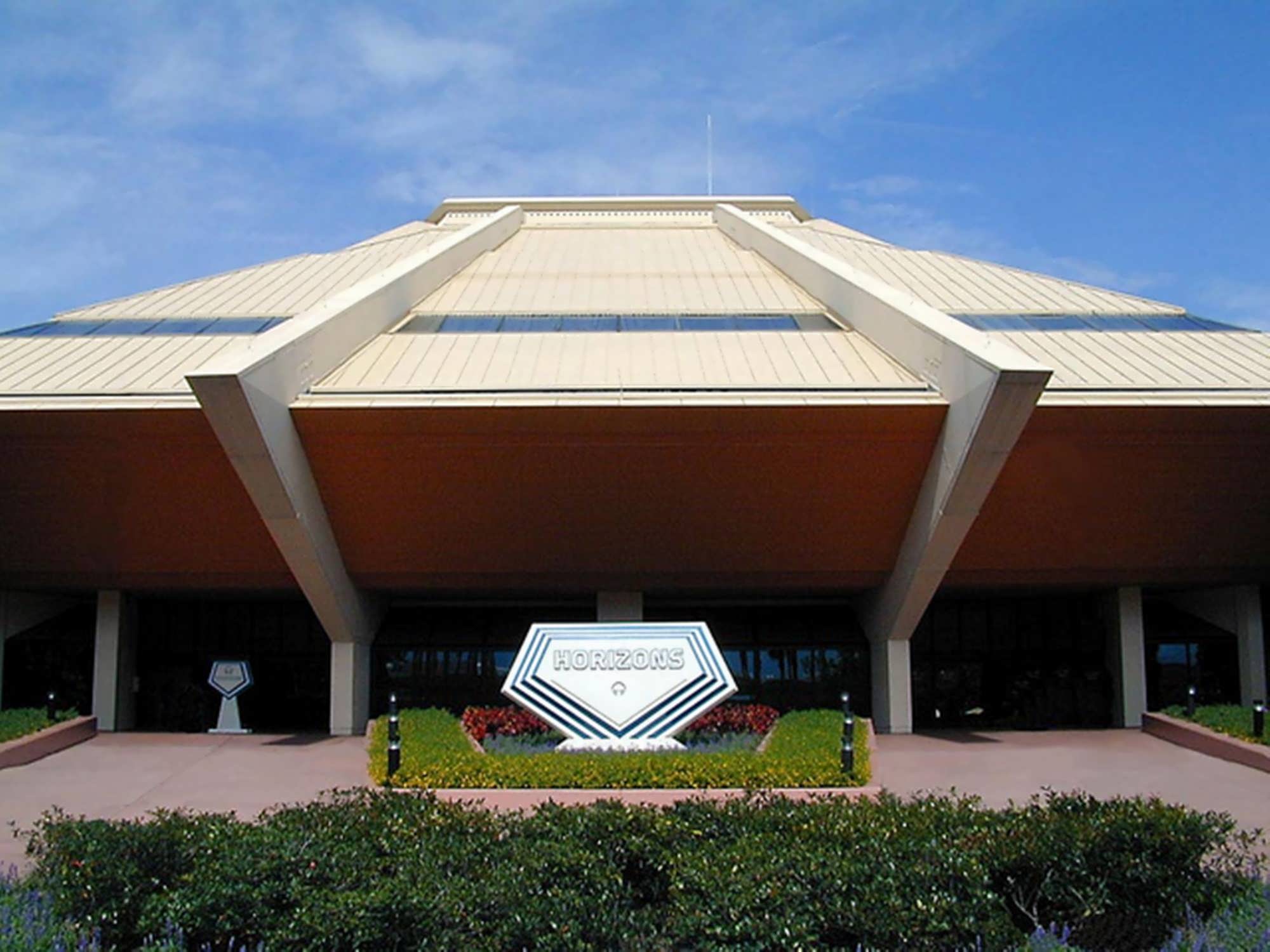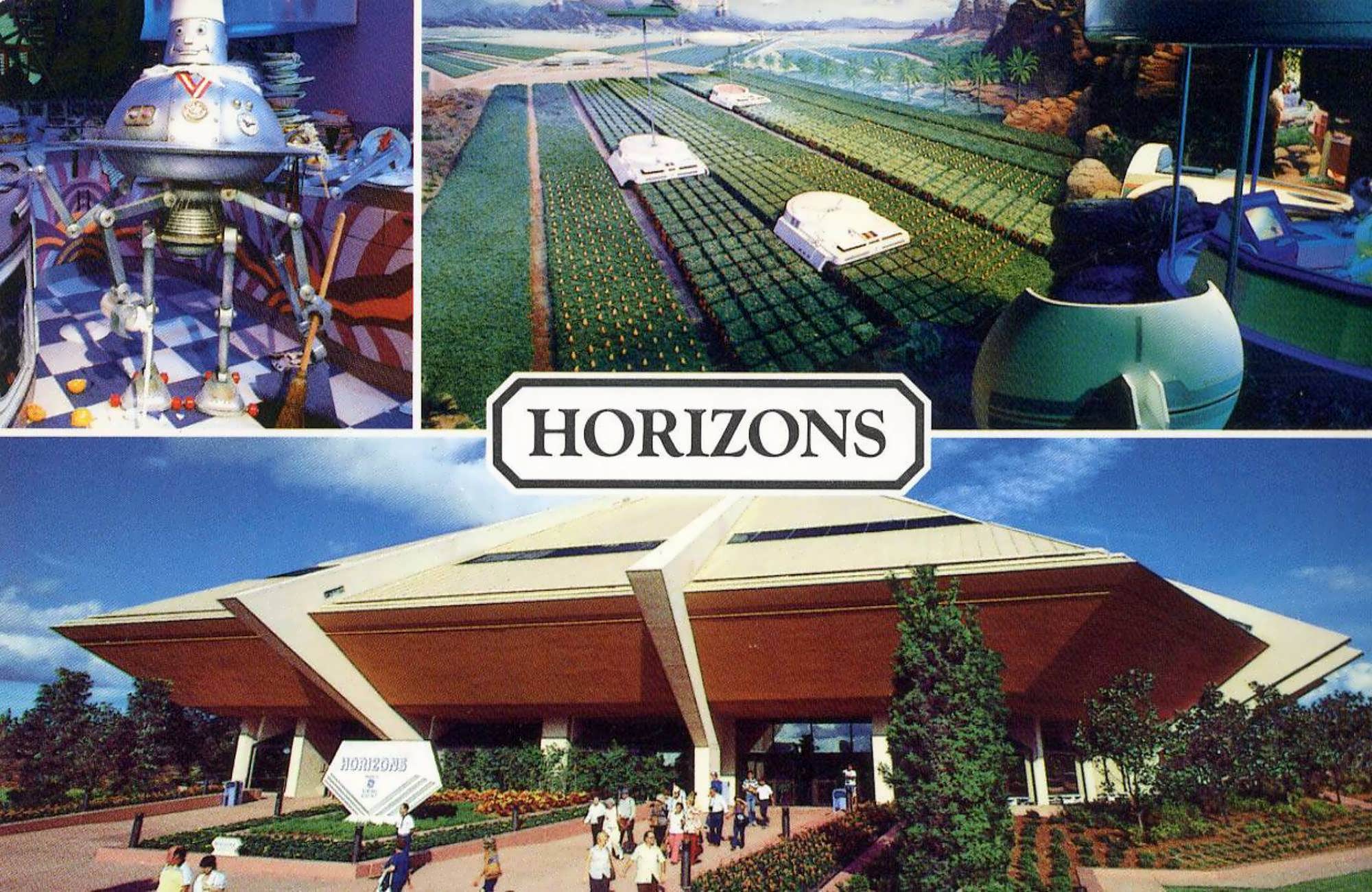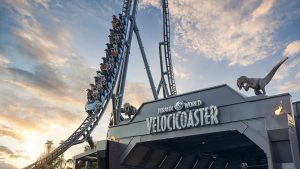Horizons, which bowed on October 1, 1983 — one year to the day after Epcot itself opened — quickly established itself as the park’s premiere attraction. In 1994, after General Electric opted not to renew its ten-year sponsorship contract, the ride was closed, only to be reopened sporadically over the course of the next several years. On January 9, 1999, the attraction closed for good; the following year, Disney tore down the pavilion — the first time that the company had ever outright demolished a show building in its then-45 years of theme park operation — and ultimately put Mission: Space in its place. Disney fans have never been the same since, consistently lamenting the ride’s closure and citing it as a symbol of what has befallen Epcot generally in the 30 years since its bright and optimistic (and Disney-character-free) beginning.

To chat about Horizons’s theming, history, and ongoing legacy — not to mention the still-lingering controversy over its demolition — a few notable names in the theme park world have been gathered and thoroughly debriefed.
First and foremost among these is Steve Alcorn, a former Imagineer (Disney’s first Systems Engineer, in fact) who helped work on Epcot’s first batch of attractions. These days, Steve wears many hats, from fiction writer to Imagineering instructor to CEO of Alcorn McrBride, Inc. He’s also published a wonderful book on his days at Epcot called Building a Better Mouse.
First, though, Steve wanted to paint a picture of what it was like to work at Epcot Center in the heady days of 1982 and ’83:
Let me talk a little bit about the history of Horizons.
Everyone knows about the mad rush to open Epcot on October 1, 1982. That’s described in my book, Building a Better Mouse. A lesser-known story is that of Horizons, which was scheduled to open October 1, 1983. That story is also one of a mad rush right up until opening day.
Why are these opening days so important? There are two reasons. One has to do with the fact that the date has been announced far in advance, and guests have scheduled vacations around them. For Horizons, it was part of the one-year anniversary celebration of Epcot Center. But there’s a more important reason: the Walt Disney Company’s fiscal year ends September 30. Any attraction that isn’t open by then can’t be depreciated for that year. The value of this depreciation is in the tens of millions of dollars, so there’s a strong financial incentive to open on time.
When Epcot opened, I was working on The American Adventure, the most complex attraction. I had been on a business trip to Florida for four months and expected I’d be going home soon. This didn’t happen. Fix-up work on American Adventure continued for many months, as the hydraulics were redesigned, requiring major changes to the control system. Then I was drafted to open the Imagination Pavilion, an attraction scheduled to open October 1 that hadn’t made it.
By the summer of 1983, Imagination was open, and I turned my attention to the Epcot park-wide monitoring system. This is a system that collects the status of 30,000 points throughout all of the park’s pavilions. It hadn’t made it by opening day, either. In addition to monitoring, the system also provided some pavilions with essential services. Because it was critical in American Adventure, I had written a custom program to operate the monitor cabinet in that attraction.
With the Horizons opening date looming, the monitor system suddenly became very critical. That’s because it was used for tape starts, and Horizons had a massive number of these.
Computers have become so all pervasive that it’s difficult to imagine a time when they weren’t everywhere, but Epcot opened before the era of the personal computer. And there was also no such thing as digital audio, so every sound in Epcot was stored on analog magnetic tape. Because tape machines tend to break, they were all located at Epcot Central. This allowed easy maintenance. But it also meant that sensors on the ride track needed to be transmitted from the individual pavilions to Epcot Central, where they caused tape machines to start audio playback, and then the audio needed to be routed all the way back to the pavilion for amplification and distribution.
The Epcot pavilions that needed tape starts up until this point had required very few, and they were being done by simple little custom programs. But Horizons had 160 different tape starts! And as the vehicles moved around the ride, these were triggered over and over, creating a massive number of messages that needed to travel back and forth between the pavilion and Epcot Central. With the monitor system software still incomplete, there was simply no way to accomplish this.
And so, in the summer of 1983, I began a frantic effort to convert my custom code from American Adventure’s monitor cabinet into code that could be used throughout all of Epcot, and especially in Horizons. It was another case of things going down to the wire, and we didn’t have tape starts running the audio in Horizons until just days before its opening on October 1, 1983.
<script async src=”//pagead2.googlesyndication.com/pagead/js/adsbygoogle.js”></script>
Why is Horizons considered to be the best Disney attraction?
I don’t know that Horizons was Disney’s best attraction, but it was a very good one. The combination of World of Motion, Universe of Energy, Imagination, and Horizons all in one park was an impressive array of E-ticket attractions. Sadly, the only one of those that remains is Energy, and it has been heavily modified.
Each of these attractions really pushed the edge of available technology. Remember, this was an era before the PC. Horizons, in particular, combined an impressive suspended ride system with dramatic sets, lots of animatronics, a good storyline, and not one, but two Omnimax theaters tipped on their sides to create a sphere through which the vehicles traveled.

Why has Horizons lived on so fervently? Is it more of the ride specifically, or has it become something of a symbolic touchstone?
One of the reasons Horizons is so fondly remembered is because, like the other lost pavilions at Epcot, it could only be experienced in person, and it was never adequately captured on video, so those who didn’t have a chance to experience it can only wonder what it was like.
What is the one scene or detail that embodies the attraction’s overall narration or ethos?
For me, the transcendent moment in Horizons was when the vehicles entered the double Omnimax theater. Suspended from an unseen overhead rail, they seemed to float into this enormous space, the depth of which was impossible to gauge. Then, all around you, a space shuttle launch would take place, or you’d skim over the surface of a microchip or deep beneath the ocean. The experience was so much more dramatic than that of, say, Soarin’ Over California that it makes the latter experience seem tame, plotless, and boring. Which it is!
Do you know why the pavilion was closed? There seems to be conspiracy theories abound on the net…
Horizons closed for the same reason all attractions close: money. Nearly all the original pavilions at Epcot were partially paid for by corporate sponsors. These sponsors paid for both the construction and the annual maintenance costs of the attractions, and they usually signed on for ten-year contracts. When these contracts expired, some of the sponsors didn’t renew them. To attract new sponsors required new pavilions. In other cases, such as World of Motion and Imagination, the original sponsors stayed on but wanted their pavilions to be freshened. Unfortunately, by this point, the creative staff that designed Epcot was largely gone, and the replacement attractions, while often expensive, never measured up to the attractions they replaced.
So we are left with only the memories of World of Motion, Journey into Imagination, the original Energy preshow, and the fondly-remembered Horizons.
To continue on to the second part of this article, click here. Before you go, you may be interested in viewing this Horizon tribute video, as it will help bring to life many of the details we are discussing:
Still sad that Horizons and its like are long gone from Epcot? Still hopeful for the park’s future? Be sure to share your thoughts below.
Planning a vacation to Orlando?
Want to skip all the work and just price out a vacation to Universal Orlando? We’ll find the best deals for you – for free (seriously.) Learn more, or check out some of the current deals:
- – Halloween Horror Nights 25 Hotel & Ticket Vacation Packages
– Wizarding World of Harry Potter Vacation Packages
– 2-Park Getaway at Universal Orlando

